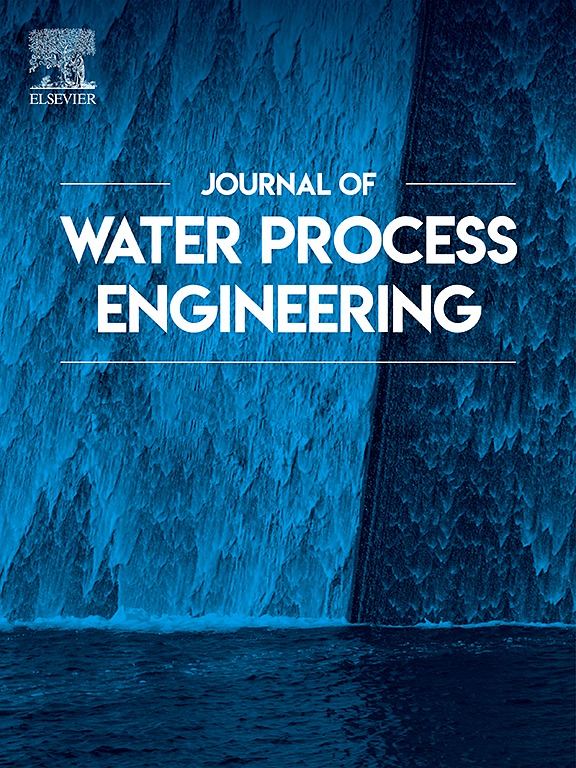Airlift reactor-based heterogeneous catalytic ozonation using CuO@Leca for biodegradability enhancement of quercetin-rich pharmaceutical effluent
IF 6.3
2区 工程技术
Q1 ENGINEERING, CHEMICAL
引用次数: 0
Abstract
Herbal pharmaceutical effluent (HPE) is distinguished by its high content of natural flavonoids such as Quercetin. Heterogeneous catalytic ozonation (HCO) in an airlift reactor (600 mL) was applied to degrade Quercetin in an aqueous environment using copper oxide-loaded light-expanded clay aggregate (CuO@Leca). Prepared catalyst was characterized by BET, XRD, FTIR, EDS, and SEM analysis, while GC–MS and UV–visible spectroscopy were used to evaluate HPE characterizations. In the first part of experiments, the influence of three main variables, namely CuO loading (0–20 wt%), pH (4–10), and ozonation time (5–35 min) was optimized on Quercetin removal efficiency from synthetic HPE. The results showed a significant increase (2–5 times) in Quercetin degradation using HCO compared to ozonation alone. Meanwhile, an 86.34 % removal was achieved at pH 7.4 and high level of other variables. In the second part of the experiments, real HPE was subjected to HCO under the optimal CuO loading determined in the first part of experiments. Significant reduction was achieved in Quercetin concentration (84 %), TSS (96 %), turbidity (92 %), COD (86 %), and BOD (80 %), alongside an improvement in HPE biodegradability from 0.41 to 0.59. The liquid flow in the riser of airlift reactor promotes the dispersion and direct reactions of ozone, while the catalyst-ozone interactions in the downcomer accelerate ozone decomposition and generation of reactive species, leading to the formation of smaller and more biodegradable compounds such as flavonol, chalcone, flavone, flavanon, flavan-3-ol, oxonium, and phenol. The suggested catalytic reactor is practically interested than slurry configuration. The spent catalyst was regenerated via aerobic calcination at 450 °C for 2 h, showing ∼9 % efficiency loss after four recycling cycles.

求助全文
约1分钟内获得全文
求助全文
来源期刊

Journal of water process engineering
Biochemistry, Genetics and Molecular Biology-Biotechnology
CiteScore
10.70
自引率
8.60%
发文量
846
审稿时长
24 days
期刊介绍:
The Journal of Water Process Engineering aims to publish refereed, high-quality research papers with significant novelty and impact in all areas of the engineering of water and wastewater processing . Papers on advanced and novel treatment processes and technologies are particularly welcome. The Journal considers papers in areas such as nanotechnology and biotechnology applications in water, novel oxidation and separation processes, membrane processes (except those for desalination) , catalytic processes for the removal of water contaminants, sustainable processes, water reuse and recycling, water use and wastewater minimization, integrated/hybrid technology, process modeling of water treatment and novel treatment processes. Submissions on the subject of adsorbents, including standard measurements of adsorption kinetics and equilibrium will only be considered if there is a genuine case for novelty and contribution, for example highly novel, sustainable adsorbents and their use: papers on activated carbon-type materials derived from natural matter, or surfactant-modified clays and related minerals, would not fulfil this criterion. The Journal particularly welcomes contributions involving environmentally, economically and socially sustainable technology for water treatment, including those which are energy-efficient, with minimal or no chemical consumption, and capable of water recycling and reuse that minimizes the direct disposal of wastewater to the aquatic environment. Papers that describe novel ideas for solving issues related to water quality and availability are also welcome, as are those that show the transfer of techniques from other disciplines. The Journal will consider papers dealing with processes for various water matrices including drinking water (except desalination), domestic, urban and industrial wastewaters, in addition to their residues. It is expected that the journal will be of particular relevance to chemical and process engineers working in the field. The Journal welcomes Full Text papers, Short Communications, State-of-the-Art Reviews and Letters to Editors and Case Studies
 求助内容:
求助内容: 应助结果提醒方式:
应助结果提醒方式:


